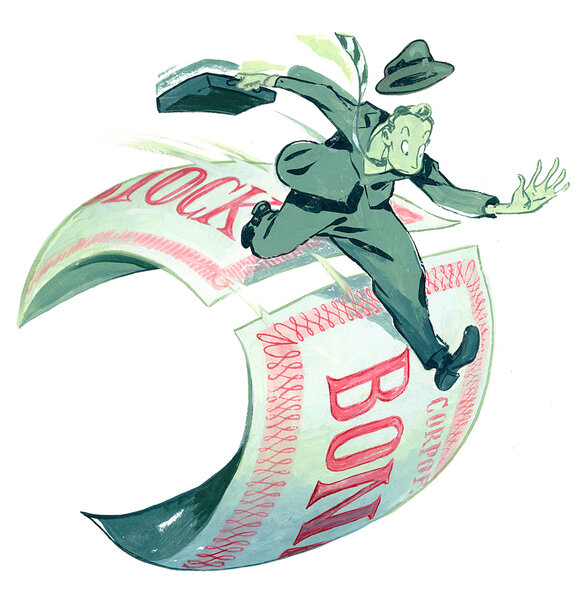Bond bubble or not, bonds are getting risky
Loading...
Safety seekers, beware! That big bond portfolio may be riskier than you think.
A return of volatility has sent some stock investors running to the bond market. Others, tired of earning close to zero in bank accounts, are moving cash into bonds. For five of the first six months of 2010, investors have held 20 percent or more of their portfolios in bonds, says the American Association of Individual Investors. The average is 15 percent.
"I'm getting more money [from clients] than I know what to do with," says William Larkin, fixed-income portfolio manager for Cabot Money Management in Salem, Mass. "They have all this money parked in banks, all their operating capital, and it's moving to me because they're not interested in losing money" as inflation rates exceed interest rates.
But bond investors need to tiptoe through a minefield of risks that people wouldn't normally associate with an investment haven like bonds. Some economists are now calling the influx of money a bond bubble, perhaps as treacherous as the dot-com bubble a decade ago. The trick, investment professionals say, is to manage that risk by investing for the short term, looking beyond what are often considered the safest bond instruments, and not putting all one's eggs in a bond basket.
"Going all into bonds may be adding much more potential risk than what you may see on the surface," says John Flahive, Boston-based director of fixed income at BNY Mellon Wealth Management.
The obvious risk is a hike in interest rates. Hovering near 50-year lows since 2008, they'll have to rise sometime – some say within the coming year – driving down bond prices. Then, not only will today's bond investor be holding low-yielding issues, those issues may be worth less than their original price.
Another risk is inflation. With 10-year US Treasury notes yielding around 3 percent at the end of July, a small rise in inflation could mean investors lose money in inflation-adjusted terms.
The biggest risk is that buying the safest bonds, such as Treasuries, may make it hard for people to grow their money at all. "The cost of safety today is brutal," Mr. Larkin says. "Very few investment objectives can be achieved with Treasuries, with the yields they're producing, or with [certificates of deposit] or money markets."
Bonds are still useful in smoothing out market volatility, investment advisers say. But investors will have to use counter-intuitive risk-reducing strategies.
Larkin, for example, sees better opportunities in bonds traditionally regarded as somewhat riskier than Treasuries. Investment-grade corporate bonds, for instance, have been offering yields 1 to 1.5 percentage points higher than those of 10-year Treasuries. Larkin likes bonds from household names with scant prospects for default, such as PepsiCo, General Electric, The Home Depot, and Boeing.
Another risk-reducing strategy involves forgoing the higher yields on long-term bonds. While long-term issues can appear safer, they won't be if rising interest rates push bond prices down.
"Anything that's paying decent money has got to be long term, and long term is a trap," says David Lesnick, a certified financial planner in Goodyear, Ariz. When interest rates go up, "long-term bonds are the ones that take the worst hit.
Mr. Lesnick- suggests locking in yields for shorter terms, such as two years.
Bond investors have options beyond buying individual bonds through a brokerage. They can buy into a bond mutual fund or a bond exchange-traded fund that focuses on short-dated securities, such as bonds maturing in 2011 and 2012. This allows investors to reap the benefits of diversification through a basket of bonds.
"If you're going to buy corporate bonds, it wouldn't be smart to put all your eggs in one basket and buy just one particular issuer, because if something goes wrong with that company, that could be very negative for you," says Anne Briglia, senior fixed-income strategist at UBS Wealth Management Americas Research.
Niche investment vehicles may also help bond investors gird for potential turmoil in bond markets. Mr. Flahive notes that "real return" funds give investors access not only to bonds but also other asset classes that can help hedge against inflation, such as commodities and Treasury Inflation-Protected Securities. Larkin also sees advantages for some investors to go with so-called step-up bonds. These have long-term horizons and built-in yield increases at specific intervals, which help protect against inflation. Example: a 15-year note issued by Morgan Stanley on July 9 pays 5 percent initially, then climbs to 6, 8, 10, and 12 percent at designated intervals if it's not called by certain dates.
With pitfalls aplenty, some income-seeking investors might look outside the bond market. Dividend-paying blue chip stocks have been trading at a discount in recent weeks, relative to historic price-to-earnings ratios. That could lead some to decide that, compared with bonds, stocks may not be so risky after all.






